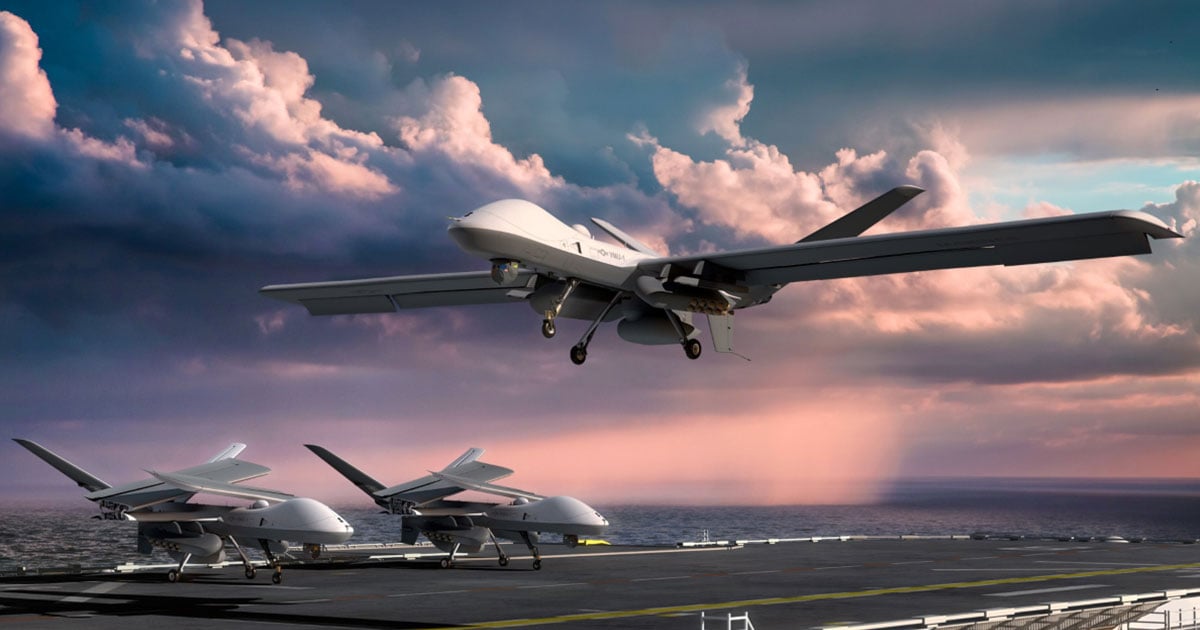Click Here to View This Page on Production Frontend
Click Here to Export Node Content
Click Here to View Printer-Friendly Version (Raw Backend)
Note: front-end display has links to styled print versions.
Content Node ID: 407447
General Atomics Aeronautical Systems (GA-ASI) announced on May 10 that it is beginning the development of a short takeoff and landing (STOL) version of its MQ-9B SkyGuardian/SeaGuardian remotely piloted aircraft (RPA). The core airframe and systems will be the same as those on the current MQ-9B, which has been ordered by the UK (as the Protector), Belgium, and the Japan Coast Guard, but the STOL version features a new broad-chord wing with high-lift devices and new tail surfaces.
Development of the STOL MQ-9B is part of GA-ASI’s Mojave initiative, which got underway in 2017 and first took to the air last year in the form of a modified MQ-1C Gray Eagle Extended Range air vehicle. The MQ-9B is larger and more powerful and will benefit from the ability to operate from shorter airfields. It will also be able to operate from aircraft carriers and large-deck amphibious assault vessels. This could be of considerable interest to potential customers such as the UK, U.S. Navy, and U.S. Marine Corps.
GA-ASI envisages the concept not as an entirely new vehicle but rather as an optional wing and tail kit that converts a standard MQ-9B into an MQ-9B STOL. It is being designed so that the conversion can be completed in less than a day.
“Imagine taking the hardtop off your Jeep. You lift it off, stow it in your garage, and now you’ve got an open vehicle," said GA-ASI president David R. Alexander. "If it rains, you put the hardtop back on. We’re the same. Take a standard MQ-9B, put the STOL kit on, and then go fly.”
To cater to shipborne operations, the MQ-9B STOL is being designed with a folding wing so that it can be parked with a small deck or hangar footprint. The wing folds are asymmetric so that the long outer wings can fold to lie one in front of the other, keeping the height of the folded RPA within hangar limits. The vehicle can maneuver on deck with its wings folded, and they can be unfolded when in clear deck space prior to launch.
The RPA’s STOL performance permits it to launch and recover without any deck aids such as catapults or arrester mechanism. Large-deck assault carriers, which operate STOVL fixed-wing aircraft such as the AV-8B and F-35B, lack these features, anyway. The MQ-9B’s automatic takeoff and landing systems can be integrated into existing ship systems, including the Joint Precision Approach and Landing System found on U.S. carriers. Start-up and launch of the MQ-9B are conducted from a compact laptop and, once the vehicle is airborne, control of the RPA can be handed over to other controllers, such as remote land-based ones using satellite communications, or to a manned aircraft in manned-unmanned teaming missions.
In a naval scenario, the MQ-9B STOL could be used for a wide variety of missions, including its core persistent intelligence, surveillance, and reconnaissance (ISR) tasks. As such it can provide an around-the-clock defensive watch around naval formations. In the SeaGuardian configuration, it can provide maritime surveillance and conduct anti-submarine warfare, and it could also undertake airborne early-warning duties.
